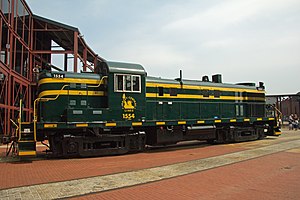This article includes a list of general references, but it lacks sufficient corresponding inline citations. (June 2017) |
The ALCO RS-3 is a 1,600 hp (1.2 MW), B-B diesel-electric locomotive manufactured from May 1950 to August 1956 by American Locomotive Company (ALCO) and its subsidiary Montreal Locomotive Works (MLW). A total of 1,418 were produced: 1,265 for American railroads, 98 for Canadian railroads, 48 for Brazilian railroads, and seven for Mexican railroads.
| ALCO RS-3 | |||||||||||||||||||||||||||||||||||||||
|---|---|---|---|---|---|---|---|---|---|---|---|---|---|---|---|---|---|---|---|---|---|---|---|---|---|---|---|---|---|---|---|---|---|---|---|---|---|---|---|
 A former Central Railroad of New Jersey ALCO RS-3 at Steamtown National Historic Site | |||||||||||||||||||||||||||||||||||||||
| |||||||||||||||||||||||||||||||||||||||
| |||||||||||||||||||||||||||||||||||||||
| |||||||||||||||||||||||||||||||||||||||
| |||||||||||||||||||||||||||||||||||||||
The RS-3 greatly resembled the RS-1 and RS-2,[1][2] but it had 100 more horsepower thanks to its 12-cylinder, 1,600 hp ALCO Model 244 engine. It also had some changes to the fuel system and body shape.[3]
Much like the RS-1, many RS-3s served for decades; some are still in use as of 2022.
Variants
editRSC-3: an RS-3 that used 3-axle trucks instead of 2-axle trucks. The middle axle on each truck was unpowered. This variant was designed for service on light track, as the extra axles better spread the weight of the locomotive.[3]
RS-3m: an RS-3s whose engines was replaced with the more reliable EMD 567B engine.
Competition
editALCO built the RS-3 to compete with EMD, Fairbanks-Morse, and Baldwin Locomotive Works—and in particular with EMD's GP7, introduced in 1949.
The arrival of the 1,500-hp GP7 led ALCO, Fairbanks-Morse, and Baldwin to increased the power of an existing locomotive line from 1,500 to 1,600 hp (1.1 to 1.2 MW) and add more improvements to create new locomotive lines. In 1950, Fairbanks-Morse introduced the 1,600 hp (1.2 MW) H-16-44, while Baldwin introduced the 1,600 hp (1.2 MW) Baldwin AS-16. ALCO's 1,500 hp (1.1 MW) line was the RS-2, although 31 were built in 1950 with 1,600 hp (1.2 MW). Fairbanks-Morse's 1,500 hp (1.1 MW) line was the H-15-44. Baldwin's 1,500 hp (1.1 MW) line was the Baldwin DRS-4-4-1500. EMD kept its GP7 at 1,500 hp (1.1 MW) until 1954, when it introduced the GP9, rated at 1,750 hp (1.30 MW).
In the end, EMD won the road switcher production race. EMD produced 2,729 GP7s. ALCO produced 377 RS-2s, and 1,418 RS-3s. Fairbanks-Morse produced 30 H-15-44s, and 296 H-16-44s. Baldwin produced 32 DRS-4-4-15s, and 127 AS-16s.
Exports
editBrazil
editIn 1952, the Brazilian railway the Estrada de Ferro Central do Brasil purchased forty six new RS-3s from the Montreal Locomotive Works. Some are still active as work train engines for CPTM, Supervia, and CBTU – BH respectively São Paulo's, Rio de Janeiro's and Belo Horizonte's commuter railways. In Brazil these units were nicknamed Canadians or Hot Tails.
Spain
editIn 1964, the Spanish railway the Ferrocarril de Langreo purchased four RS-3s from the Terminal Railroad Association of St. Louis. A fifth unit, number 1604, was purchased in 1971 from the Burlington Northern Railroad (BN), a piece of surplus Great Northern Railway stock from the 1970 merger that formed BN. The locomotives served until 1984, when the line was converted to 1,000 mm (3 ft 3+3⁄8 in) metre gauge.[4]
See also
editReferences
edit- ^ Pinkepank, Jerry A. (1973). The Second Diesel Spotter's Guide. Kalmbach Publishing Co., Milwaukee, WI. pp. 243–244. ISBN 0-89024-026-4.
- ^ Foster, Gerald L. (1996). A field guide to trains of North America. Boston: Houghton Mifflin. p. 20. ISBN 0-395-70112-0.
- ^ a b Schafer, Mike (1998). Vintage diesel locomotives. Osceola, WI: Motorbooks International. p. 52. ISBN 0-7603-0507-2. OCLC 38738930.
- ^ "Ferrocarril de Langreo en Asturias". AlcoWorld. 2000-05-14. Retrieved 2007-09-13.
Bibliography
edit- Dorin, Patrick C. (1972). Chicago and North Western Power. Burbank, California: Superior Publishing. p. 140. ISBN 0-87564-715-4.
- Solomon, Brian (2000). The American diesel locomotive. MCI Publishing Company. ISBN 0-7603-0666-4.
- Coelho, Eduardo J. J.; Setti, João B. (1993). A era diesel na EFCB. Associação dos Engenheiros Ferroviários.